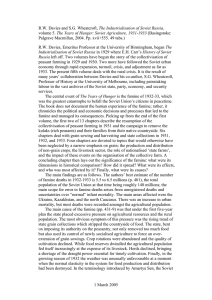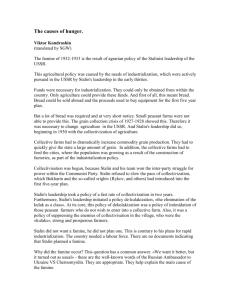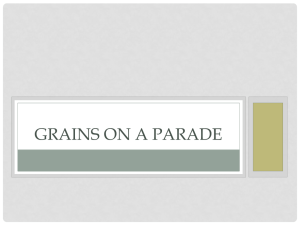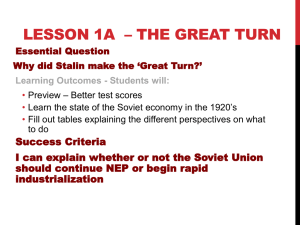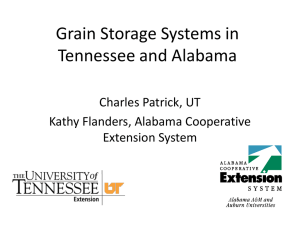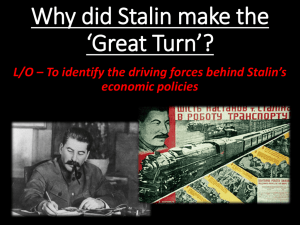Russian Society Lecture
advertisement
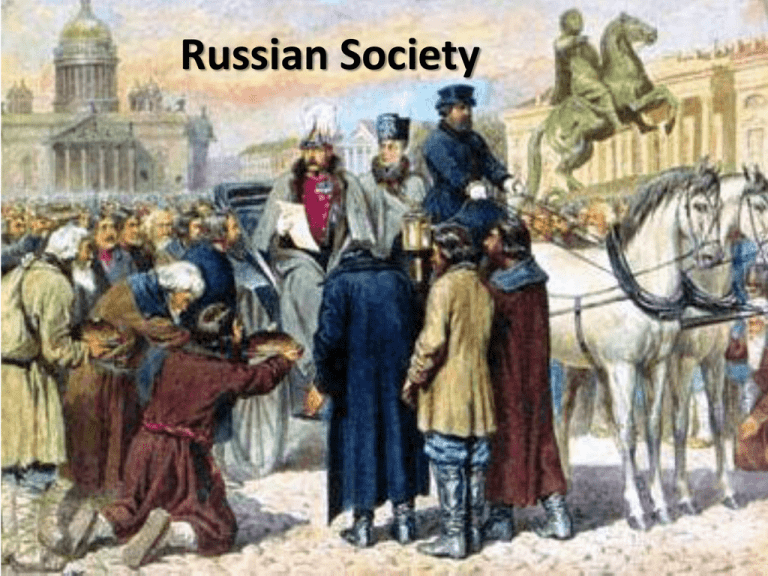
Russian Society Assess the view that nothing changed in Russian society between 1855-1964 Aims 1. To examine changes in Russian society between 1855-1964. 2. To compare reactions from Tsars and Commissars. 3. To establish change and continuity for different groups within society. Social Aspects • • • • • • • Population (growth and makeup) Education Living conditions Food vs. Famine Rural vs. urban work Civil rights Religion Population Growth Population Growth Year Population in millions Urban % 1858 74 6% 1870 86 11% 1913 166 18% 1920 137 15% 1939 191 32% • First census 1897, before was guess work. • Biggest growth between 1870 and 1914. • Urbanisation saw Moscow and St. Petersburg rocketed. • Living standards and housing suffered. Social Structure Up until 1917… • Mostly rural population, 80% dependent on agriculture, hence backward economy. • Industrial worker and peasant distinction blurred, led to “aristocracy of labour”. • Middle class began to rise, commercial vs. professional. • Nobility in decline, many had lived beyond means = amount of land owned decreased, but hardcore remained. Government policies • 1861 saw freedom to marry for peasants. • Civil Marriage for peasants not allowed until October 1917. • Stalin also encouraged people to have children, i.e. “Distinctions of Mother Heroines” = 10+ kids. Ouch. • Official divorce also became an option. • 1926 abortion legalised, revised after fall in birth rate, then only allowed if risk was present. • Stalin ordered financial incentives to maintain marital unit. • Restrictions lifted in 1955. Communist structure • Meant to be no class-based society, should be governed by workers. • Soviet Communism had hierarchical structure with small elite at the top. • Even workers had status rankings with technical experts valued, especially if they towed Party line. • Continuity or change? Education Education, Education, Education! Primary Schools • Pre-1864, provision through wealthy individuals or Church. • Reform post ’64 – Zemstva responsible for ed., Church still heavily involved. • From 1870, central gov. had more say over education, Dmitri Tolstoy reduced power of Zemstva. • Nic II annouced plans for “universal primary education” by 1922. • Primary attendance by 1930 was compulsory until 12. • 1929 – 8m kids in Primary school. • 1930 – 18m kids in Primary school. • “War on literacy” – extra course = revolution and religion disappeared. Secondary Schools • Grammar schools vs. institutions for vocations and academia. • Al II allowed “real gymnasia” with modern languages, science and maths (fear of revolution), and “traditional gymnasia” with classics and P.E. • No of students in secondary ed. Doubled between 1855-1865, mainly Middle Class. • Tolstoy manipulated ed. to only allow noble kids into uni., MC were cut out. • Al III banned LC from SS!! Bolshevik reaction • Scrapped gymnasia, replaced with polytechnics. • Emphasis on skills. • 1930s saw return to mix of vocational institutions and grammar schools. • Stalin saw 2.5m kids in 1931 in SS to 6.9m in 1932. Also scrapped school fees in 1939. • Also re-wrote History! Putin anyone?! • Khrushchev went back to polytechnics. Universities – “potential breeding grounds for opposition” • Fear shown in 1861, St Petersburg students accused of sedition, privileges withdrawn. • 1863 saw new freedoms, more autonomy but Ministry for Education had last say. • Al III restricted autonomy, elections to university councils scrapped and appointments used instead. • 16,500 universities by 1900. • Women limited. • Stolypin saw repression increase even more, non academic meetings in all universities made illegal. Assess the view that economic change in Russia was more successful under Stalin than any other ruler in the period from 1855 to 1964. Housing Basic points • By 1900 only 15% of Russians lived in urban areas. • 19 cities had 100,000+ inhabitants, Petrograd 1.25m and Moscow 1m. • Urbanisation soared from 1897 = public health problems – cholera, dysentery and typhoid. • Housing conditions were poor and this led to increase in domestic abuse. Level of Tsarist development • Housing thrown up quickly, mostly wooden buildings. • 74 towns had electricity, 35 had access to gas and only 38 had a sewage system. • 100,000 died of cholera in St. Petersburg in 1910, sewage system fitted in 1911. Workers’ Housing Tsarist period Commissars Period • Workers lived in barracks. • Small scale workshops saw workers sleep on the floor. • Skilled workers had better conditions but generally speaking conditions were poor. • In 1917, the Bolsheviks wrested housing away from landlords and shared it out amongst proletariat under the oversight of the soviets. • Stalin saw living conditions deteriorate. • Overcrowding common, mid 30s Moscow saw 25% of the population living in one room. • 5% lived in a bathroom or corridor! • Stalinist policy only allocated space to individuals. • Sacrifices needed for utopia. Post WWII • Post WWII 25m people homeless. • Khrushchev main response, housing doubled between 19551964, communal living abandoned. • Housing cooperatives damaged some, employees organisations were given first choice over housing, benefitted young professionals with deposits. Rural Housing • Stays the same for most of the period. • Wooden hut (izbas) heated by an oven. • Animals housed in huts, often over crowded. • Stalin constructed “special housing” blocks near collective farms. • Khrushchev aimed to create agro-towns, often build quickly and of poor quality. • Kulaks often displaced and were left in barracks or tents! Food and Famine Agricultural problems • Over reliance on grain production (monoculture). • Role of the mir – insistence on growing certain crops. • Severe weather conditions. • Government insisted on grain requisitioning. Famines • • • • • • • 1891 Alexander II put Zemstva in charge of famine response. Adverse weather hit 50% of provinces. Cholera and typhus also hit. 350,000 died and central government blamed. Vyshnergradsky raised tax on consumer goods, so peasants sold excess grain, which led to more food shortages. Al III tried to ban grain exports, set up two lotteries and set up Committee on Famine Relief. Too little too late. • • • • • World War I/Provisional Gov. 1914-17 saw good harvests., but little seen in towns, still had bread queues. Peasants hoarded grain and poor transport meant grain difficult to move anyway. 1918 saw continuation of food crisis. Brest-Litovsk saw agricultural land disappear so Bolsheviks introduced grain requisitioning. Saw violent protest and the Cheka used to seize grain. By 1921, situation was chaotic. Sadly, famines continued Famine of 1921 Ukrainian Famine • Droughts followed by severe winters continued to bite. • Ukrainian food production fell by 20% by 1921. • 5m died in the ensuing famine, which was compounded by transport issues. • Lenin, eventually, allowed American Relief Administration in. • Mid 1920s continued to see requisitioning at times of need and blame placed on kulaks. • Death penalty imposed for stealing grain. • Peasants shot if they ate their own grain. • Discussion of grain crisis banned. • Movement restricted. • Animals slaughtered, including farm animals, which continued crisis. • By WWII consumption of meat and fish had fallen by 80%. Rural vs. Urban work Rural vs. Urban work Rural Work Urban Work • Hard labour, but before 1917 peasants could dictate tempo. • Peasants worked hard in Tsarist times to make excess crops. • Nature of work changed under Communists. • Methods and quotas decided by central government. • Collectivisation targets set and rarely achieved. • Tractors heralded as great success but in practice rarely used. • Worst conditions in factories or heavy industry. • No factory inspectorate until 1882 – even then hard to enforce. • Rabkrin introduction in 1920 only a talking shop. • Workers fined 10% of wages for wrong doing or even purged as wreckers in 1930s. • 1903 saw Workers’ insurance system and bonus schemes under Communists. • 1928-32 real wages fell by 50% and didn’t recover until 1954. Civic Freedoms Freedoms Political Freedoms • Variable and you all know it. Personal Freedoms • Variable and you know it. So what do we now know? Read over your notes and highlight sections you knew before today, sections you only discovered today and sections you want to read up on further.



